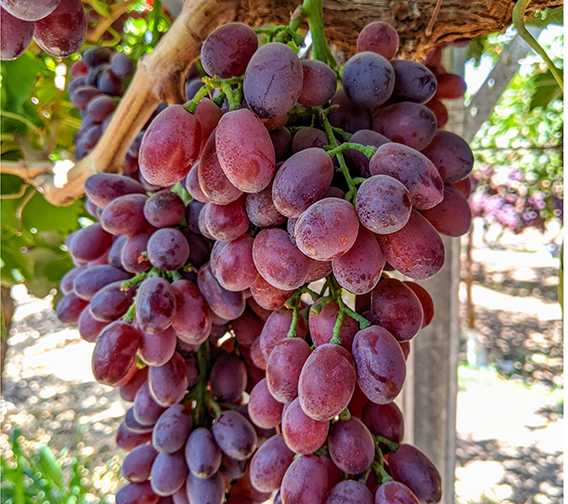Sulfur Spray Best Practices For Winegrapes
Elemental sulfur is an effective tool for controlling powdery mildew in winegrapes, but applying it late in the season comes with some concerns.
Too much elemental sulfur residue during the fermentation process can lead to the creation of the dreaded hydrogen sulfide (H2S) – also known as rotten egg gas. “It’s something that you very much do not want,” Wayne Wilcox, professor in the department of plant pathology and plant microbe biology at Cornell University, says.
Wilcox and colleagues Misha Kwasniewski and Gavin Sacks recently collaborated to answer the frequently asked question, “How long before harvest should a grower stop applying sulfur to avoid problems with residues in the wines?”
Past studies have found that sulfur residue in the juice totaling 10 parts per million should raise red flags. The parts per million in the juice correspond to how much residue is on the surface of the fruit at the time of harvest. “The problem is, you can’t measure total sulfur in something like grape juice, because some of the sulfur is the elemental sulfur, which is the spray residue, but there are proteins that also contain sulfur,” Wilcox says.
In other words, to know how much sulfur was caused by spray residue, they needed to figure out a way to measure only elemental sulfur.
Kwasniewski did just that.
“He came up with a technique to qualify elemental sulfur by converting it to another compound selectively that didn’t convert the other forms of sulfur,” Wilcox explains. “Just the elemental sulfur converted, and then that conversion product could be measured.”
Wilcox says the development of this measurement method has been a game-changer. “For years growers have asked me, ‘When do I need to quit spraying sulfur? How much can I spray without running into problems?’” he says.
And for years, his only response was that everybody has an opinion, but nobody has any data. That has now changed.
Wilcox says one of the advantages of the measurement method is that it’s easy for anyone to do. “You don’t need fancy equipment, it doesn’t take a tremendous amount of time, just some very basic knowledge and equipment that people would have in any winemaking lab,” he says.
Method For Measuring Elemental Sulfur Samples
This method works on either fresh or frozen juice or grapes. Minimizing handling of the grapes is important to prevent the sulfur from rubbing off onto your hands.
Equipment needed:
- Balance accurate to 1 g
- 120 ml flask
- Tubing
- Glass pipette
- Detection tube
Reagents needed:
- PEG 400 (a makeup and food additive)
- Dithiothreitol (reagent for sulfur conversion)
- Effervescent antacid (Alka-Seltzer)
Steps:
- Grind grape samples
- Heat sample with PEG to suspend sulfur.
- Convert sulfur to H2S by DTT addition.
- Push H2S through tube using CO2 generated by Alka-Seltzer.
- Measure the length of the tube to dark end to find out how much sulfur was in the original sample.
A more detailed description of the method, including a diagram, can be found here.
Key Findings
Over the course of three to four years, Wilcox and his colleagues looked at various spray regimens, applying a couple of different formulations of sulfur at various rates and stopping at different times prior to harvest. Using their new method of sulfur testing, they could accurately determine how much residue was on the grapes at harvest. They found that to consistently be below that 10 parts per million threshold, they had to quit spraying five weeks or more before the day of harvest.
There is, however, an asterisk that goes along with that five-week recommendation, Wilcox notes. With red wines, after crushing, the entire berry ferments in the skins to extract the color. “When you do that, the amount of sulfur that was on the berries is going to stay in the must as it ferments, and you can end up getting hydrogen sulfide from that sulfur,” he explains.
With white wine, on the other hand, the berries are typically crushed, and the particulates that are in the must are allowed to settle during clarification. Within 24 hours of pressing, those sulfur particles settle out. “We can start with as much as 50 parts per million of sulfur in the juice, where 10 is the red flag, but within 24 hours, we were down to just miniscule amounts like one-tenth or two-tenths of a part per million,” Wilcox says. “So with typical white winemaking procedures, the sulfur residue really should not be an issue. Red winemaking, five or more weeks right now is what we know as being sort of a safety zone.”
What About Rates?
Wilcox and his team tested elemental sulfur applied at two rates – 2.5 and 5 pounds. What they found is that there’s no solid answer as to what rate is ideal, because there are a lot of factors to consider.
“You’re getting into tradeoffs,” Wilcox says. “You want the residue on there to control the disease, but you don’t want it there to go into the wine.”
The good news is that toward the end of the season, the berries themselves are no longer susceptible to powdery mildew.
It used to be thought that susceptibility stopped somewhere around veraison, but new research shows that berries actually lose most of their powdery mildew susceptibility within a month after fruit set. “So by the time we’re getting into a month or six weeks before harvest, there’s not an issue with the berries becoming infected,” Wilcox says. “The issue is trying to keep the foliage clean.”
Keeping the foliage clean means the fungus can’t cause new infections that will allow it to survive during the dormant period and return next year.
“If you keep your vineyard clean from powdery mildew in one year, then you start with much less inoculum of the fungus the following year, which means it’s much easier to control than if you had allowed the disease to develop the previous season,” Wilcox says. “That’s why you would want to control the disease in the last five or six weeks before harvest.”
Having good control during mid-summer should mean there’s not a lot of inoculum around for the disease to spread. The result is less elemental sulfur needed the following year.
“The objective is to get good control early,” Wilcox adds.
That way, as you get closer to harvest, you can reduce rates and therefore minimize the amount of sulfur residue on the grapes. The result is better wine.










